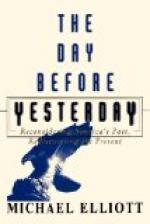Lord Lansdowne had in 1888 been transferred from Canada to India, and in May of that year he left Ottawa for Calcutta, taking on the way a three months’ well-earned holiday in England. Two of his staff accompanied him from the vigorous young West to the immemorially old East.
He succeeded as Viceroy Lord Dufferin, who had also held the appointment of Governor-General of Canada up to 1878, after which he had served as British Ambassador both at Petrograd and at Constantinople, before proceeding to India in 1884.
Lord Minto, too, in later years filled both positions, serving in Canada from 1898 to 1904, and in India from 1905 to 1910.
Whether in 1690 Job Charnock made a wise selection in fixing his trading-station where Calcutta now stands, may be open to doubt. He certainly had the broad Hooghly at his doors, affording plenty of water not only for trading-vessels, but also for men-of-war in cases of emergency. Still, from the swampy nature of the soil, and its proximity to the great marshes of the Sunderbunds, Calcutta could never be a really healthy place. An arrival by water up the Hooghly unquestionably gives the most favourable impression of the Indian ex-capital, though the river banks are flat and uninteresting. The Hooghly is one of the most difficult rivers in the world to navigate, for the shoals and sand-banks change almost daily with the strong tides, and the white Hooghly pilots are men at the very top of their profession, and earn some L2000 a year apiece. They are tremendous swells, and are perfectly conscious of the fact, coming on board with their native servants and their white “cub” or pupil. There is one shoal in particular, known as the “James and Mary,” on which a ship, touching ever so lightly, is as good as lost. Calcutta, since I first knew it, has become a great manufacturing centre. Lines of factories stand for over twenty miles thick on the left bank of the river; the great pall of black smoke hanging over the city is visible for miles, and the atmosphere is beginning to rival that of Manchester. Long use has accustomed us to the smoke-blackened elms and limes of London, but there is something peculiarly pathetic in the sight of a grimy, sooty palm tree.
The outward aspect of the stately Government House at Calcutta is familiar to most people. It is a huge and imposing edifice, but when I first knew it, its interior was very plain, and rather bare. Lady Minto changed all this during her husband’s Vice-royalty, and, with her wonderful taste, transformed it into a sort of Italian palace at a very small cost. She bought in Europe a few fine specimens of old Italian gilt furniture, and had them copied in Calcutta by native workmen. In the East, the Oriental point of view must be studied, and Easterns attach immense importance to external splendour. The throne-room at Calcutta, under Lady Minto’s skilful treatment, became gorgeous enough for the most exacting Asiatic,




